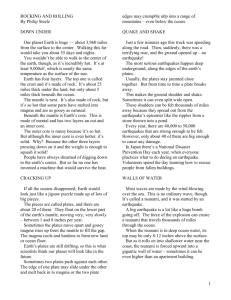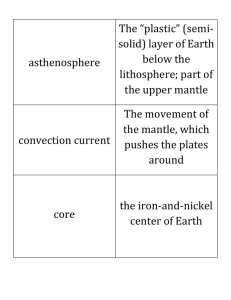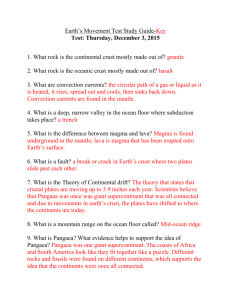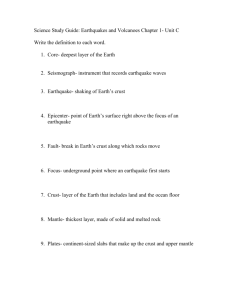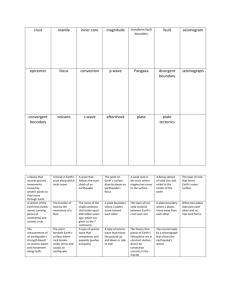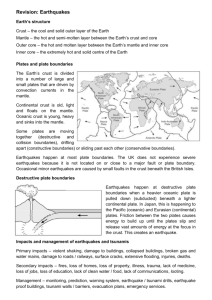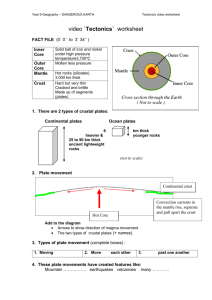File
advertisement
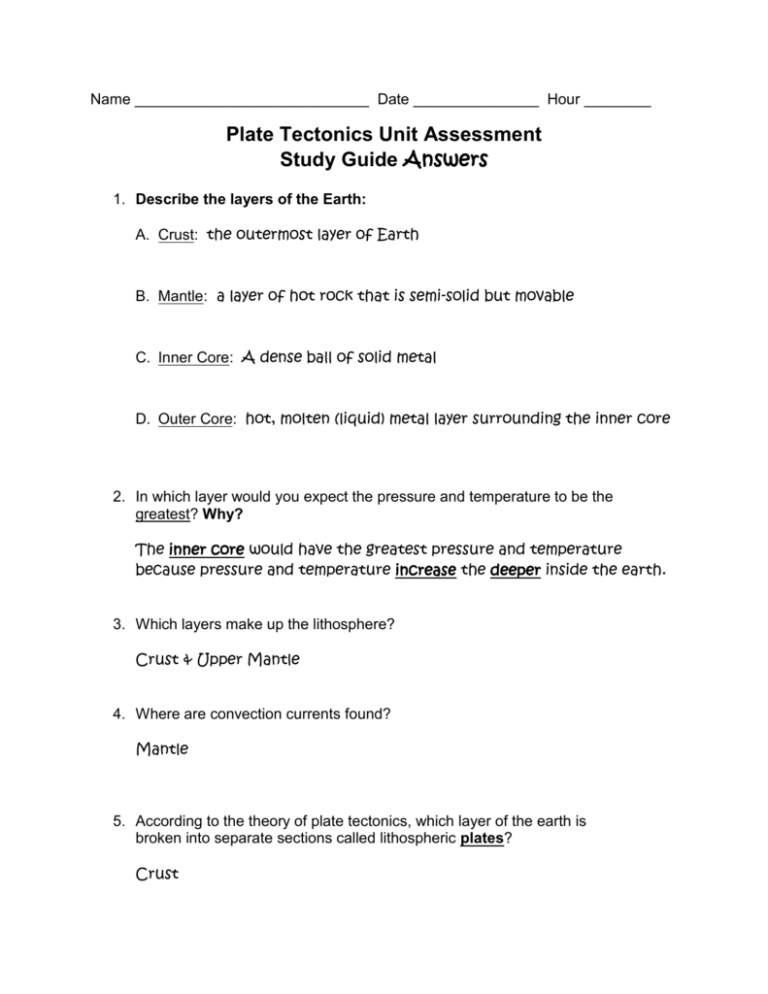
Name ____________________________ Date _______________ Hour ________ Plate Tectonics Unit Assessment Study Guide Answers 1. Describe the layers of the Earth: A. Crust: the outermost layer of Earth B. Mantle: a layer of hot rock that is semi-solid but movable C. Inner Core: A dense ball of solid metal D. Outer Core: hot, molten (liquid) metal layer surrounding the inner core 2. In which layer would you expect the pressure and temperature to be the greatest? Why? The inner core would have the greatest pressure and temperature because pressure and temperature increase the deeper inside the earth. 3. Which layers make up the lithosphere? Crust & Upper Mantle 4. Where are convection currents found? Mantle 5. According to the theory of plate tectonics, which layer of the earth is broken into separate sections called lithospheric plates? Crust 6. Explain Wegener’s hypothesis. The continents were once joined together in a single landmass (Pangaea) and are slowing drifting apart (Continental Drift). 7. What is Pangaea? The name of the supercontinent that existed millions of years ago. 8. How fast do the plates move each year? A few centimeters a year. 9. What is the name of the geological theory that states that pieces of Earth’s lithosphere are in constant, slow motion? The Theory of Plate Tectonics 10. Explain and draw a picture of each type of plate boundary movement. A. Convergent: Two plates moving towards each other. B. Subduction: A type of Convergent movement, but one plate slides under the other plate. C. Divergent: Two plates move away from each other D. Transform: Two plates moving along side each other in opposite directions. 11. Explain sea-floor spreading. The process where new crust is continually being added to the ocean floor (example: along both sides of the Mid-Atlantic Ridge). 12. Name the processes that can change the surface of the earth? Erosion / weathering Plate movement (Mountain building & Volcanoes & Earthquakes) Glacier movement 13. What is the geologic time scale and how is it divided up into sections? A record of the life forms and geologic events in Earth’s history. It is divided up into sections based on when major changes occurred during earth’s history. 14. What is a fossil? How do most fossils form? Why are fossils important? A fossil is the preserved remains or traces of an organism. Most fossils form when living things die and their remains are buried by sediment. Fossils are important because they provide a record of: life on Earth how organisms have changed over time how organisms responded to environmental changes over time 15. Earthquakes – Explain the following terms: A. Earthquake: vibrations in the earth caused by a sudden slip in plates along a fault. B. Richter Scale: measures how much energy an earthquake releases B. Epicenter: the location directly above the where the earthquake originates, on the surface of the earth. C. Seismic Waves: the waves that travel through the earth during an earthquake. 16. In which direction do the waves carry the energy of an earthquake? The seismic waves of an earthquake carry the energy away from the focus in all directions. 17. Sometimes the rocky layers of opposite sides of a fault jam against each other, “locking” sections of the fault and preventing them from moving for a while. Pressure builds up in that section of the crust until the blockage is broken and the fault slips suddenly. What is that sudden slip called? Earthquake 18. Can geologists predict earthquakes? Why or why not? No – geologists can’t be sure when or where the stress will be released along a fault. 19. Why is the risk of earthquakes high along the Pacific coast of the United States? The risk is high because that’s where the Pacific and North American plates meet resulting in many faults. 20. Vocanoes – Explain the following terms: A. Lava: The molten mixture of rocks at the earth’s surface. B. Magma: The molten mixture of rock deep in Earth’s mantle. C. Hot Spot: An extremely hot region within the Earth’s mantle, where magma melts through the crust in the middle of a plate. D. Viscosity: the thickness of lava or magma 21. Where do volcanic belts form? What is the name of the belt of volcanoes around the rim of the Pacific Ocean? Volcano belts form along the boundaries of Earth’s plates. Ring of Fire 22. Describe and draw a shield volcano. Discuss viscosity of the magma. Gentle sloped sides – like a mound Low viscosity magma (thin) Low silica content 23. Describe and draw a strato volcano. Discuss the viscosity of the magma. Steep sides – like a triangle High viscosity magma (thick) High silica content 24. Explain what happens to viscosity of magma when the temperature changes. Viscosity increases as temperature decreases. (lower temperature = thicker magma)
